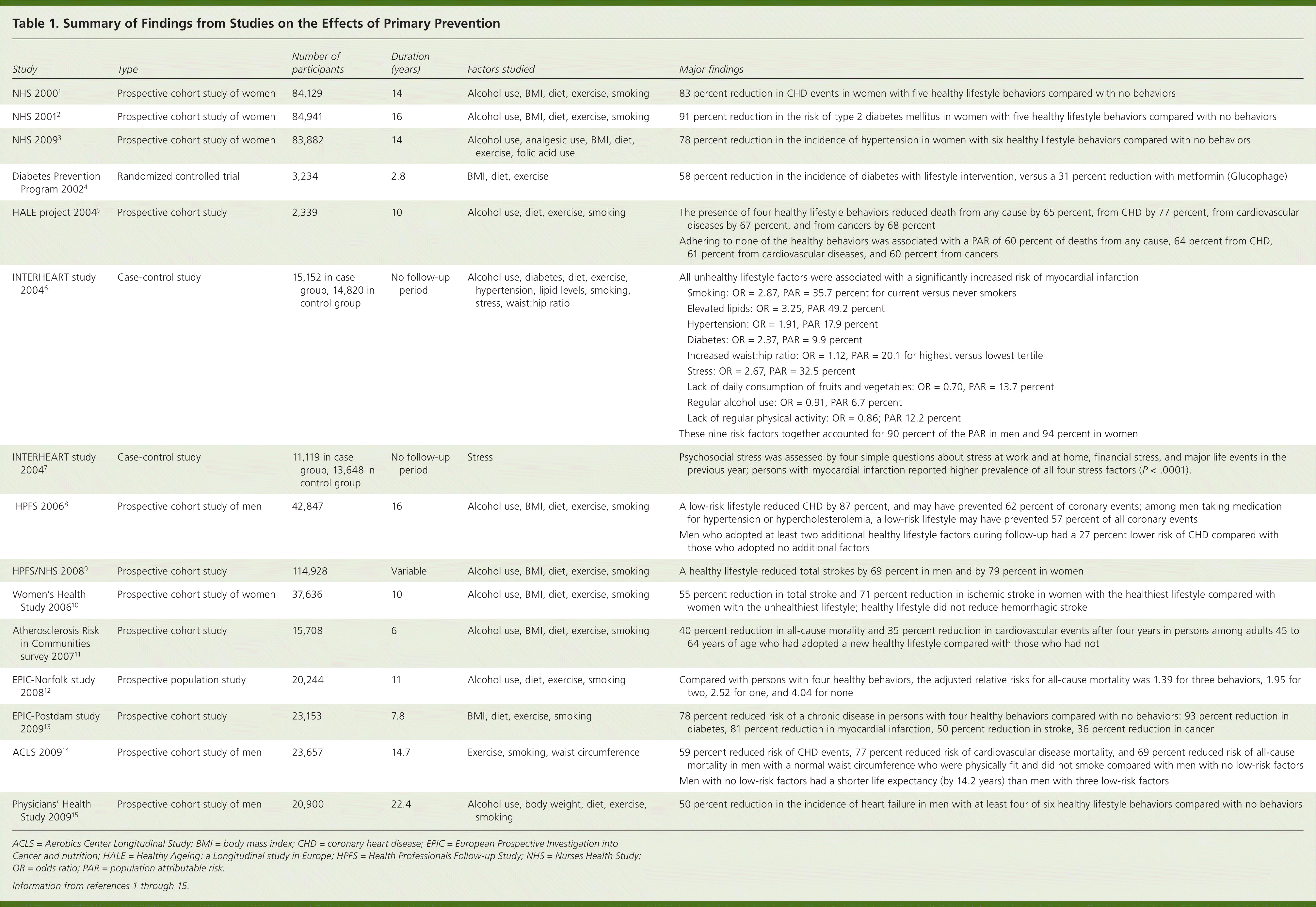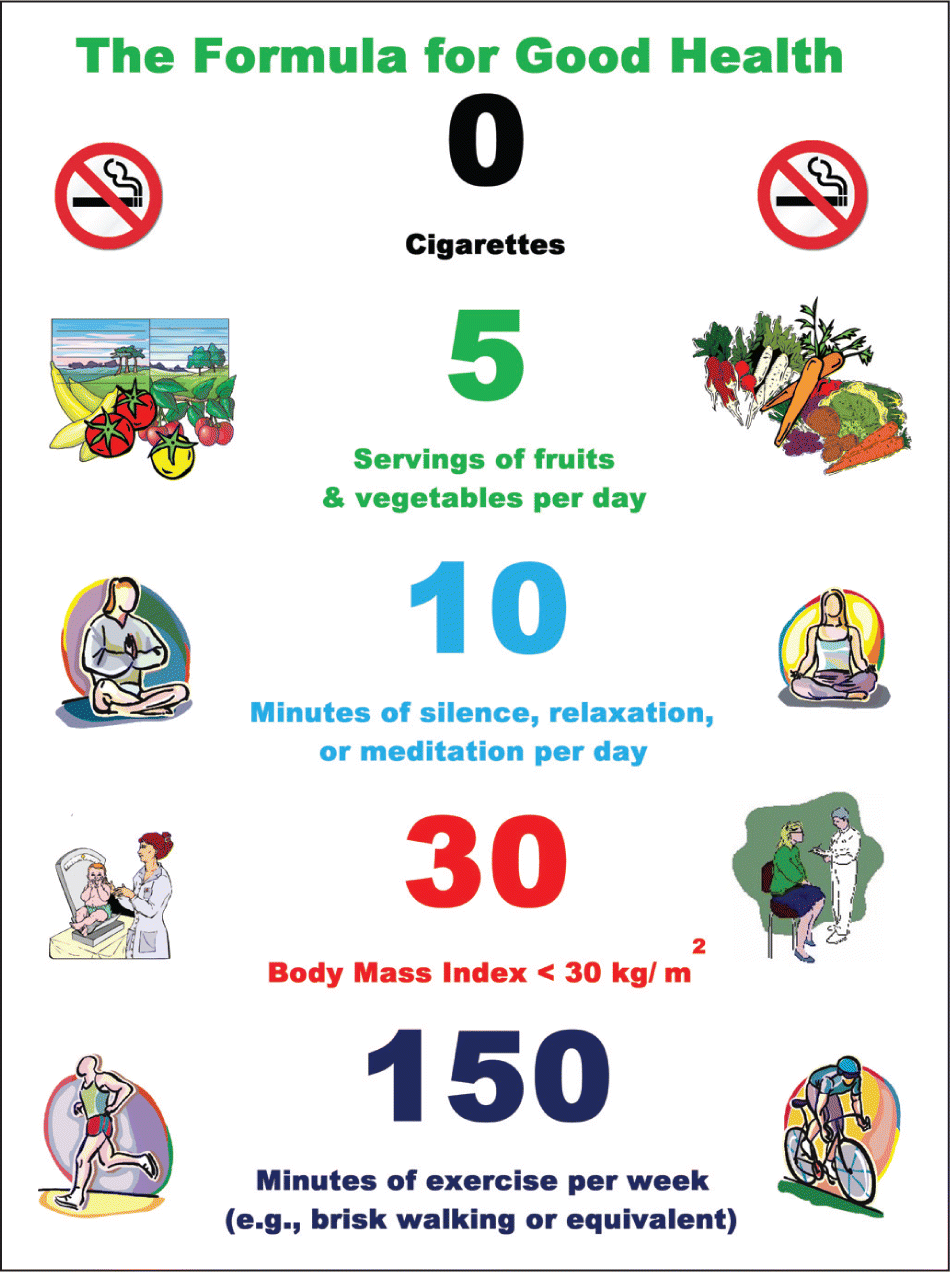
Am Fam Physician. 2010;82(6):610-614
Author disclosure: Nothing to disclose.
It is time to make a decision. Which will be our health promotion strategy—primary prevention or secondary prevention?
Traditionally, the only one available to us was secondary prevention. Medicine consisted of a one-on-one physician-patient relationship, and taking care of patients meant minimizing the impact of any diseases the patient had. We did not have the time or tools to do anything else. More recently, we have been able to reduce a patient's mortality by 20 to 30 percent by treating heart disease with a statin or beta blocker. These two medications have had the most dramatic effects in secondary prevention.
But now, the way we practice medicine has changed. We have a real choice to make. According to recent literature, primary prevention appears to work better than any other strategy in medicine. So why do some physicians not implement primary prevention? Despite the literature, maybe physicians are not getting the news. We need to keep repeating the message to physicians and patients that primary prevention is simple and effective. Next, we need to take a look at our own behavior as physicians and determine if it makes sense in the context of primary prevention.

| Study | Type | Number of participants | Duration (years) | Factors studied | Major findings |
|---|---|---|---|---|---|
| NHS 20001 | Prospective cohort study of women | 84,129 | 14 | Alcohol use, BMI, diet, exercise, smoking | 83 percent reduction in CHD events in women with five healthy lifestyle behaviors compared with no behaviors |
| NHS 20012 | Prospective cohort study of women | 84,941 | 16 | Alcohol use, BMI, diet, exercise, smoking | 91 percent reduction in the risk of type 2 diabetes mellitus in women with five healthy lifestyle behaviors compared with no behaviors |
| NHS 20093 | Prospective cohort study of women | 83,882 | 14 | Alcohol use, analgesic use, BMI, diet, exercise, folic acid use | 78 percent reduction in the incidence of hypertension in women with six healthy lifestyle behaviors compared with no behaviors |
| Diabetes Prevention Program 20024 | Randomized controlled trial | 3,234 | 2.8 | BMI, diet, exercise | 58 percent reduction in the incidence of diabetes with lifestyle intervention, versus a 31 percent reduction with metformin (Glucophage) |
| HALE project 20045 | Prospective cohort study | 2,339 | 10 | Alcohol use, diet, exercise, smoking | The presence of four healthy lifestyle behaviors reduced death from any cause by 65 percent, from CHD by 77 percent, from cardiovascular diseases by 67 percent, and from cancers by 68 percent |
| Adhering to none of the healthy behaviors was associated with a PAR of 60 percent of deaths from any cause, 64 percent from CHD, 61 percent from cardiovascular diseases, and 60 percent from cancers | |||||
| INTERHEART study 20046 | Case-control study | 15,152 in case group, 14,820 in control group | No follow-up period | Alcohol use, diabetes, diet, exercise, hypertension, lipid levels, smoking, stress, waist:hip ratio | All unhealthy lifestyle factors were associated with a significantly increased risk of myocardial infarction
|
| These nine risk factors together accounted for 90 percent of the PAR in men and 94 percent in women | |||||
| INTERHEART study 20047 | Case-control study | 11,119 in case group, 13,648 in control group | No follow-up period | Stress | Psychosocial stress was assessed by four simple questions about stress at work and at home, financial stress, and major life events in the previous year; persons with myocardial infarction reported higher prevalence of all four stress factors (P < .0001). |
| HPFS 20068 | Prospective cohort study of men | 42,847 | 16 | Alcohol use, BMI, diet, exercise, smoking | A low-risk lifestyle reduced CHD by 87 percent, and may have prevented 62 percent of coronary events; among men taking medication for hypertension or hypercholesterolemia, a low-risk lifestyle may have prevented 57 percent of all coronary events |
| Men who adopted at least two additional healthy lifestyle factors during follow-up had a 27 percent lower risk of CHD compared with those who adopted no additional factors | |||||
| HPFS/NHS 20089 | Prospective cohort study | 114,928 | Variable | Alcohol use, BMI, diet, exercise, smoking | A healthy lifestyle reduced total strokes by 69 percent in men and by 79 percent in women |
| Women's Health Study 200610 | Prospective cohort study of women | 37,636 | 10 | Alcohol use, BMI, diet, exercise, smoking | 55 percent reduction in total stroke and 71 percent reduction in ischemic stroke in women with the healthiest lifestyle compared with women with the unhealthiest lifestyle; healthy lifestyle did not reduce hemorrhagic stroke |
| Atherosclerosis Risk in Communities survey 200711 | Prospective cohort study | 15,708 | 6 | Alcohol use, BMI, diet, exercise, smoking | 40 percent reduction in all-cause morality and 35 percent reduction in cardiovascular events after four years in persons among adults 45 to 64 years of age who had adopted a new healthy lifestyle compared with those who had not |
| EPIC-Norfolk study 200812 | Prospective population study | 20,244 | 11 | Alcohol use, diet, exercise, smoking | Compared with persons with four healthy behaviors, the adjusted relative risks for all-cause mortality was 1.39 for three behaviors, 1.95 for two, 2.52 for one, and 4.04 for none |
| EPIC-Postdam study 200913 | Prospective cohort study | 23,153 | 7.8 | BMI, diet, exercise, smoking | 78 percent reduced risk of a chronic disease in persons with four healthy behaviors compared with no behaviors: 93 percent reduction in diabetes, 81 percent reduction in myocardial infarction, 50 percent reduction in stroke, 36 percent reduction in cancer |
| ACLS 200914 | Prospective cohort study of men | 23,657 | 14.7 | Exercise, smoking, waist circumference | 59 percent reduced risk of CHD events, 77 percent reduced risk of cardiovascular disease mortality, and 69 percent reduced risk of all-cause mortality in men with a normal waist circumference who were physically fit and did not smoke compared with men with no low-risk factors |
| Men with no low-risk factors had a shorter life expectancy (by 14.2 years) than men with three low-risk factors | |||||
| Physicians' Health Study 200915 | Prospective cohort study of men | 20,900 | 22.4 | Alcohol use, body weight, diet, exercise, smoking | 50 percent reduction in the incidence of heart failure in men with at least four of six healthy lifestyle behaviors compared with no behaviors |
Although these studies offer a complex array of data to sift through, the elements of a healthy lifestyle are clear: not smoking, regular exercise, healthy diet, healthy body weight, and reduced stress.
Although exercise guidelines vary, I ascribe to the U.S. Department of Health and Human Services' Physical Activity Guidelines for Americans, which recommends at least 150 minutes of brisk walking or the equivalent per week.16 For the diet criterion, the Atherosclerosis Risk in Communities study illustrates that merely consuming five servings of fruits and vegetables per day is associated with the same benefits as consumption of a Mediterranean-style diet.11 A standard of five servings of fruits and vegetables is much easier to remember and adhere to.
There is strong support for at least one weight-related variable in a healthy lifestyle. This may include body weight, body mass index (BMI), waist circumference, or waist:hip ratio. The INTERHEART study showed waist:hip ratio to be the most predictive of cardiovascular disease.6 However, unlike BMI calculation, measurement of weight:hip ratio has not yet become standard in U.S. practices. I use BMI as the metric, and a value less than 30 kg per m2 as the cutoff between a healthy and unhealthy lifestyle. The goal is to move away from this outer limit toward a more ideal parameter, such as less than 25 kg per m2.
The final variable of a healthy lifestyle, which has strong support from the INTERHEART study, is stress reduction.7 The INTERHEART study offers useful suggestions for measuring stress—perception of severe stress at home or at work, financial stress, or major life events.7 The minimal lifestyle intervention that would be beneficial is not defined. However, 15 to 20 minutes of silence, relaxation, or meditation appears to be a common interval.17 To be more inclusive of patients, I set the criterion to an even less restrictive amount, about 10 minutes per day.17 This is enough time to produce a change in biorhythms and is achievable for most patients. Figure 1 presents a formula to make healthy lifestyle goals simple and accessible.

Information alone does not lead to behavior change, however. Motivational interviewing or brief negotiation is a new framework that can close the gap between knowledge of available lifestyle interventions and changing behaviors. The framework has already been proven markedly effective for tobacco, drug, and alcohol addiction.18 Few physicians have received the training necessary to implement motivational interviewing or brief negotiation. Resources for learning about these skills include the Kaiser Permanente Medical Group Web site (http://www.kphealtheducation.org/bnroadmap/index.html) and the book Motivational Interviewing in Health Care: Helping Patients Change Behavior.18
In terms of health, we can have it all. We have the requisite tools to convert knowledge into healthy behaviors. This newfound power to reduce diabetes, heart disease, stroke, cancer, and all-cause mortality with primary prevention strategies should impel us to change how we counsel patients. Research is needed to explore why some physicians are not making this change.
